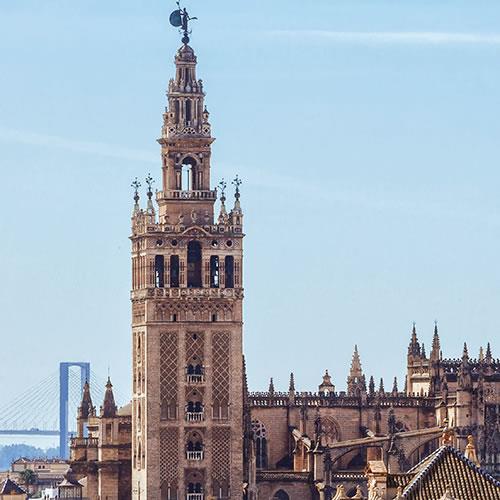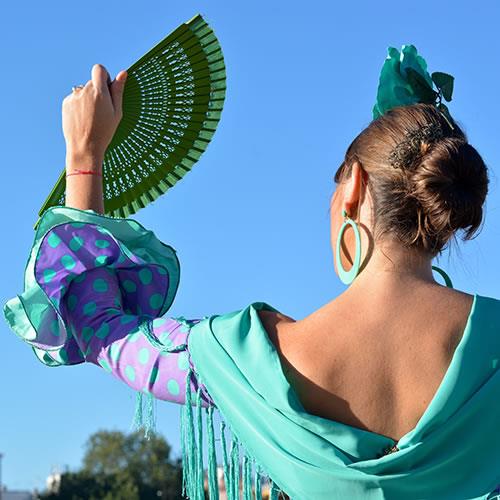Day 1 in Seville
Arrive at the train station in Seville and proceed to your hotel. Should you desire, we offer private transfers where a representative will meet you at the train station and transfer you to your hotel. (Click on Hotel Transportation in the Booking Process.) Check into your hotel and head to the Barrio Santa Cruz, the old Jewish Quarter, with its charming maze of narrow streets and iron-gated patios scented by orange blossoms, and enjoy lunch in one of the picturesque street side cafes.
After lunch, visit the Catedral de Sevilla, the enormous Gothic church that houses the tombs of Christopher Columbus, King Fernando III and King Alfonso X as well as hundreds of priceless works of art including paintings by Bartolomé Esteban Murillo and Francisco de Goya. Then, for amazing panoramic views of the city, climb Giralda Tower, the former minaret of a mosque, that was turned into a bell tower and is now the symbol of Seville. And be sure to see the beautiful baroque façade of the Palacio Arzobispal (Archbishop`s Palace).
Following your tour of the cathedral complex, you may want to stop at the Archivo de Indias, which holds millions of historical documents from Spain`s conquests in the New World. Then proceed to the Ayuntamiento (City Hall) and Iglesia del Salvador before visiting the Casa de Pilatos, still a private residence and one of the most visited museums in Seville. This evening, head back to the old quarter for a romantic carriage ride or for drinks and tapas at Casa Román, on Plaza de los Venerables. Afterwards, take in a traditional Flamenco show at any of the popular tablaos to be found throughot the old quarter.


Day 2 in Seville
Make sure you take some time to see such highlights in the city as the Plaza de España and Parque de Maria Luisa as well as the Triana neighborhood. If you have more time in the morning, considering taking a Guadalquivir River cruise where you will get to see the University of Seville, the Old Tabac Factory (of Carmen opera fame) in addition to the Palacio de San Telmo followed by a lovely river cruise where you will see the Torre del Oro, Triana Bridge and the famous Isla de la Cartuja and its Monastery where Christopher Columbus lived for some years.
This afternoon, it`s all about the Real Alcázar, the oldest royal seat in Spain. Originally built for the Moorish caliphs, it was later taken over by the Catholic Kings. Its mix of Arab and Christian Gothic architecture as well as its lush and lavish gardens makes it one of the most beautiful palaces in Spain. Plan to spend at least two hours here in order to fully appreciate its tiled courtyards, refreshing fountains and perfumed gardens.
Following a leisurely tour of the Alcazar, make your way to the Plaza de Toros before continuing on to the Museo de Bellas Artes. Founded in 1839, this is one of the most important museums in Spain featuring works from medieval to modern, with an emphasis on the Seville school. This includes artists such as Francisco de Zurbarán, Juan de Valdes Leal and Murillo. Other artists on display are Francisco Pacheco, Velazquez and Cano as well as El Greco and Goya.
This evening, enjoy a relaxing dinner and shopping along Calle Sierpes. Or if you have not already done so then be sure to see a Flamenco show - no trip to Seville would be complete without this experience!



Day 3 in Seville
Start the morning like the locals with tostadas and coffee `en vaso` (in a glass) or with churros and chocolate before heading to the Parque Maria Luisa and its centerpiece, the enormous Plaza de España, together designated as an UNESCO World Heritage Site. This large area south of the city center was the site of the Expo 1929 and is an oasis of exotic trees, shady paths and tranquil ponds. It is a delightful place for a stroll and is dotted with gazebos and colorful, tiled benches for you to relax and enjoy the scenery. Besides the Plaza de España, be sure to see the other hidden sites within the park gardens, including the Plaza de America, the Mudéjar Pavilion (Pabellón Mudéjar), the Museum of Arts and Traditions and the Museum of Archaeology.
Following a picnic lunch, cross the Guadalquivir River to Triana to see the Castillo San Jorge, the former headquarters of the Inquisition and to do a little souvenir shopping - this district is famous for its azulejos (ceramic tiles), made in traditional workshops using mud from the river bank. Here you will also find the old communal patios, like Castilla 16, where the gitano (gypsy) families used to live; many artists, bullfighters and flamenco performers, were born here and this is the place where you can experience some of the most authentic performances in the city. Finally, one of the city`s best loved statues of the Virgin Mary, along with La Macarena, is the Esperanza de Triana, located in the Capilla de los Marineros.
Finish the evening with dinner and unrivaled city views in one of the excellent riverfront restaurants along Calle Betis.


Additional Days in Seville
Should you be able to spend additional days in Seville then be sure to explore the Barrio Santa Cruz in more depth. You may also want to visit the Palacio de la Condesa de Lebrija, a lavish Mudejar palace built in the 1400s and declared one of the best decorated in Europe. Also of interest are the Columnas de Hércules, located in the Alameda de Hercules (so named for the poplar trees planted there and the columns featuring likenesses of not just Hercules but also Caesar), and the Basilica de la Macarena, the focal point of the beautiful La Macarena neighborhood. Don`t forget to stop by the state-of-the-art multi-million-Euro Acuario de Sevilla, where you can learn about Ferdinand Magellan`s trip around the world through the various sea life he was sure to encounter on his trip.

Your Last Day in Seville
Depart your hotel for the airport for your return home. We recommend that you purchase a private transfer, if so a representative will meet you at the hotel, in time to take you to the airport for your flight out.
